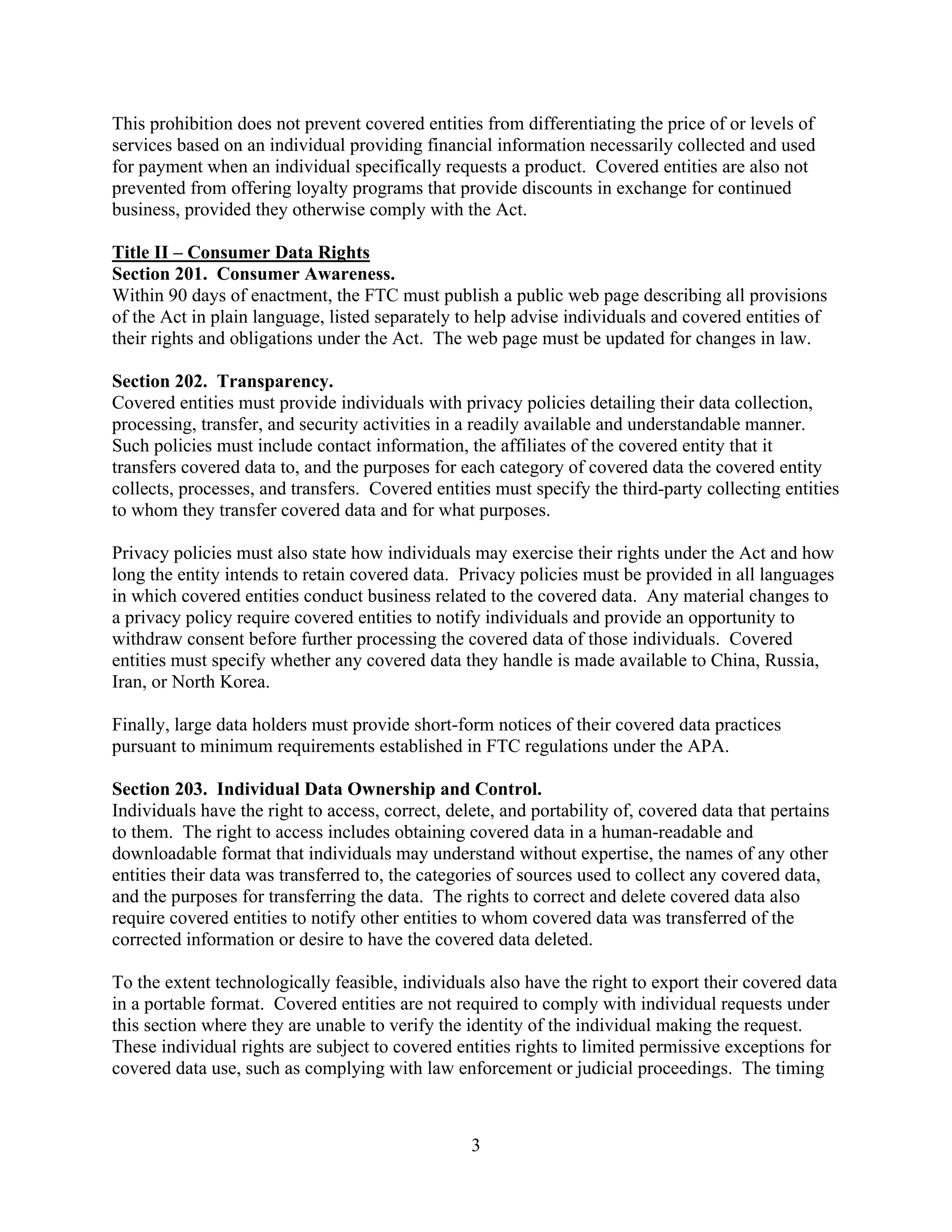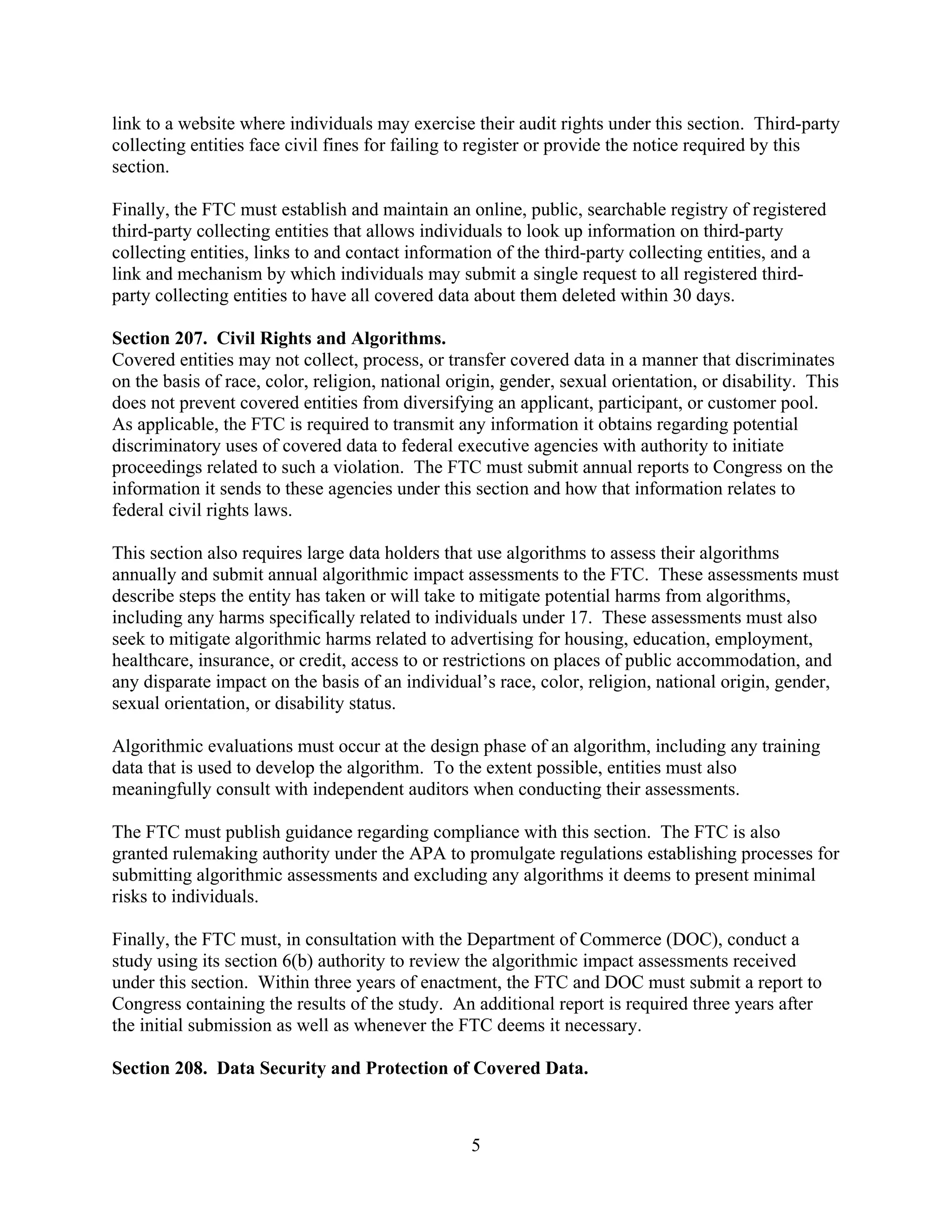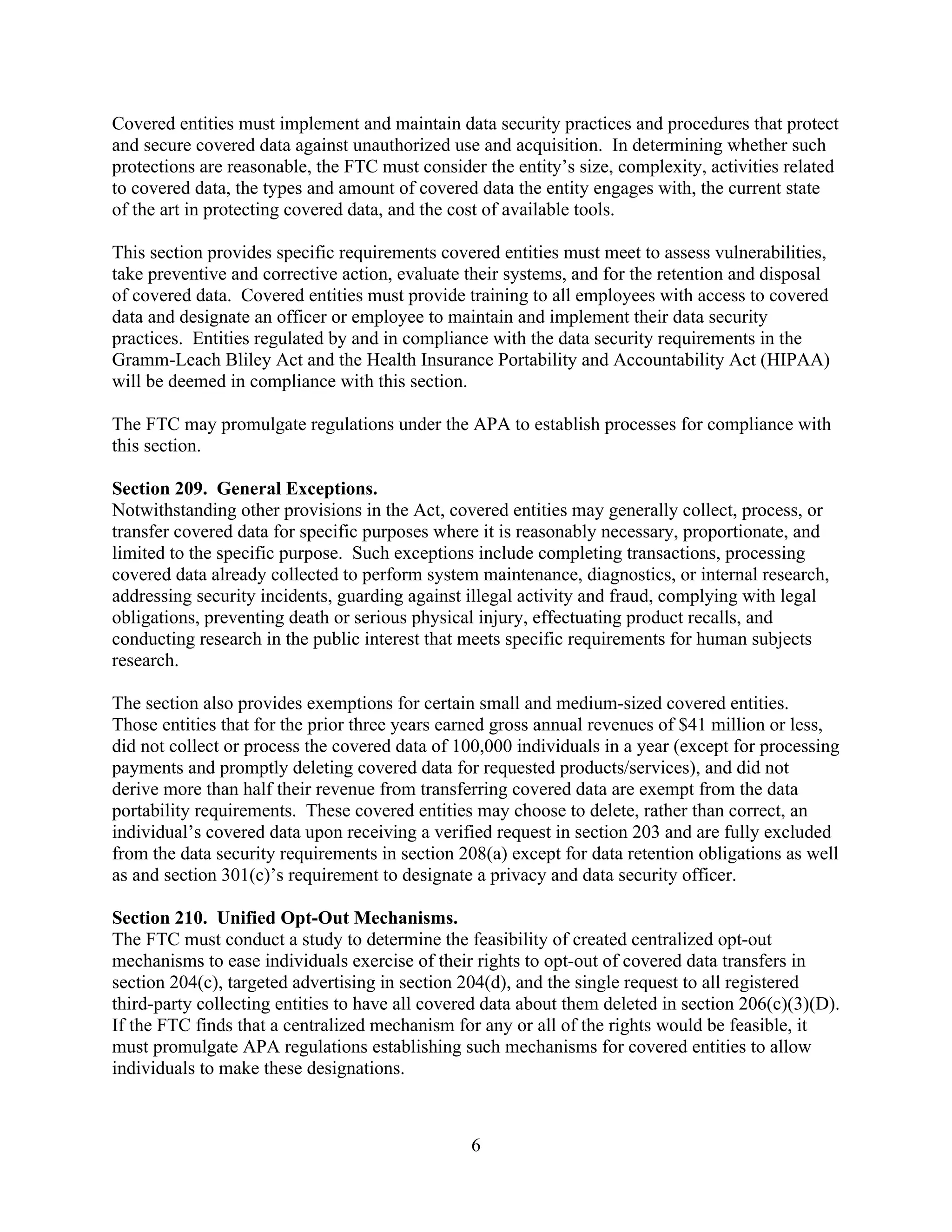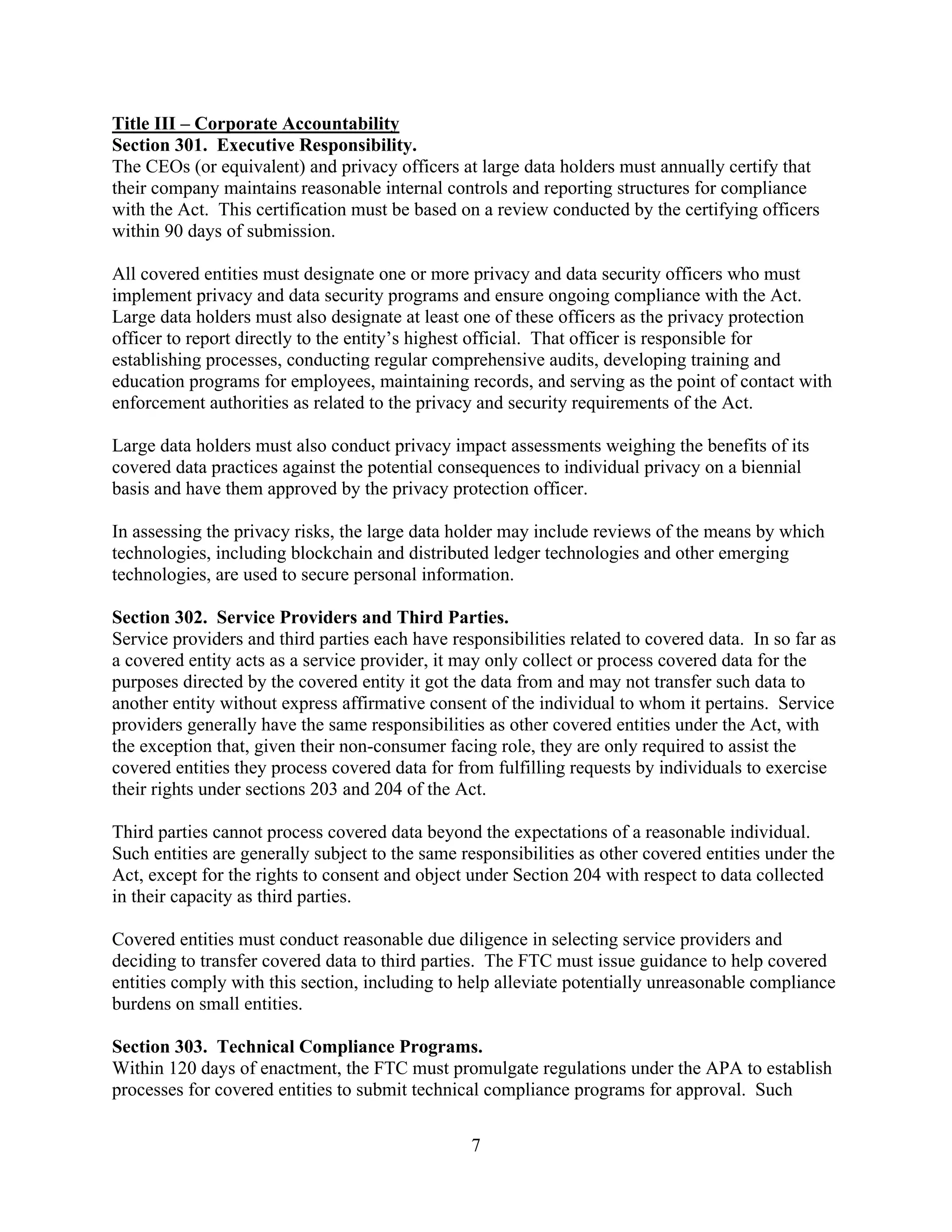This document provides a section by section summary of proposed legislation called the American Data Privacy and Protection Act. Some key points:
- It would establish definitions for terms like "covered entity", "covered data", and "sensitive covered data". Covered entities would include companies that collect or process personal data.
- It outlines various individual rights for access, correction, deletion and data portability of personal data. Covered entities would need to provide transparency into their data practices and privacy policies.
- It establishes duties for covered entities around data minimization, security, and "privacy by design". It restricts certain uses of sensitive data and requires consent for things like targeted advertising.
- It addresses issues like third
![1
American Data Privacy and Protection Act Draft Legislation
Section by Section Summary
Section 1. Short Title; Table of Contents.
The title of the Act will be the “American Data Privacy and Protection Act.”
Section 2. Definitions.
The Act defines “covered entity” to include any entity that collects, processes, or transfers
covered data and is subject to the jurisdiction of the Federal Trade Commission (FTC), including
nonprofits, and telecommunications common carriers. “Covered data” is defined as information
identifying, linked, or reasonably linkable to an individual or device linkable to an individual.
This includes derived data and unique identifiers, but does not include de-identified data,
employee data, or publicly available information (each of which is separately defined).
“Sensitive covered data” is also defined and subject to heightened requirements. Any
information related to individuals under 17 is sensitive. Sensitive covered data also includes
government-issued identifiers not required to be displayed in public such as social security and
passport numbers; past, present, and future health, diagnosis, disability, or treatment information;
financial account, debit card, and credit card numbers along with any access code, password, or
credentials; biometric information; genetic information; past or present precise geolocation
information; private communications such as voicemail, email, text or information identifying
parties to communications; any account or device log-in credentials; information revealing race,
ethnicity, national origin, religion, union membership status, sexual orientation, or sexual
behavior that violates an individual’s reasonable expectations on disclosure; information
revealing online activities over time and across third party online services; calendar, address
book, phone, text, photos, audio and video recordings maintained for private use on a device;
photos or videos of naked or undergarment-clad private areas; and information revealing
individuals access to or viewing of TV, cable, or streaming media services.
Any other covered data collected, processed, or transferred for the purpose of identifying
sensitive covered data is also considered sensitive. The FTC is granted rulemaking authority
under the Administrative Procedure Act (APA) to include additional categories of covered data
within the sensitive covered data definition where those categories require similar protection as a
result of new methods for collecting or processing covered data.
“Biometric information” and “genetic information” are each specifically defined.
“Third-party collecting entities” (commonly referred to as data brokers or information brokers),
“service providers”, and “third parties” are all defined subsets of covered entities. “Large Data
Holders” are covered entities with gross revenues above $250 million [and / that] collected,
processed, or transferred covered data of over 5 million individuals/devices or the sensitive
covered data of 100,000 individuals/devices in the most recent calendar year.
“Collecting” means acquiring covered data by any means. “Processing” means any operation or
set of operations performed on covered data. “Transferring” means to disclose, make available,
or license covered data by any means or in any way. Together these terms dictate the actions of
covered entities and individuals with respect to covered data.](https://image.slidesharecdn.com/bipartisanprivacydiscussiondraftsectionbysection39-220604103739-7139692f/75/Bipartisan_Privacy_Discussion_Draft_Section_by_Section39-pdf-1-2048.jpg)


![4
for covered entities to respond to such requests depends on whether covered entities are large
data holders or meet the requirements of small and mid-sized entities.
The FTC is authorized to promulgate APA regulations as necessary to establish processes for
compliance with this section, taking into consideration various characteristics of different
covered entities and their activities with respect to covered data.
Section 204. Right to Consent and Object.
Sensitive covered data may not be collected, processed, or transferred to a third party without the
express affirmative consent of the individual to whom it pertains. Individuals must be provided
the means to provide and withdraw consent by the same clear, conspicuous, and easy to use
means. Individuals may opt out of the transfer of any covered data to a third party.
Covered entities engaged in targeted advertising must provide individuals with clear and
conspicuous means to opt out prior to any targeted advertising and at all times afterwards.
Section 205. Data Protections for Children and Minors.
Covered entities are subject to additional requirements for covered data with respect to
individuals under age 17. Targeted advertising is expressly prohibited [if covered entities have
actual knowledge that an individual is under 17]/[to any individual under 17]. Covered entities
may not transfer the covered data of individuals between 13 and 17 years old to third parties
without express affirmative consent [where the covered entity has actual knowledge the
individual is between 13 and 17].
This section establishes a Youth Privacy and Marketing Division at the FTC, which shall be
responsible for addressing privacy and marketing concerns with respect to children and minors.
The division must submit annual reports to Congress and hire staff that includes experts in youth
development, data protection, digital advertising, and data analytics.
This section also requires the FTC Inspector General to submit a report to Congress every two
years analyzing the fairness and effectiveness of the safe harbor provisions in the Children’s
Online Privacy Protection Act of 1998 (COPPA). These reports must be published on the FTC
web site.
Notably, there are several other important provisions with heightened or specific call-outs to
children and minors throughout the legislation.
Section 206. Third-party collecting entities.
Third-party collecting entities must place a clear and conspicuous notice on their web site and/or
mobile application informing individuals they are a third-party collecting entity using language
specified by FTC regulations. The FTC must promulgate regulations under the APA that require
third-party collecting entities to allow for auditing of any access to or disclosure of covered data
related to individuals that is processed by the third-party collecting entity.
Third-party collecting entities that process covered data of more than 5,000 individuals must
annually register with the FTC. Registration includes paying a $100 fee, providing information
about the third-party collecting entity’s activities, providing contact information, and creating a](https://image.slidesharecdn.com/bipartisanprivacydiscussiondraftsectionbysection39-220604103739-7139692f/75/Bipartisan_Privacy_Discussion_Draft_Section_by_Section39-pdf-4-2048.jpg)





![10
Existing federal law and the authority of federal agencies is generally not limited except where
specified in the Act. Covered entities subject to and in compliance with the related data privacy
and security requirements of certain specified federal laws shall be held to be in compliance with
the related laws of the Act solely and exclusively to the extent that covered data is subject to the
requirements in the other laws. The FTC must issue guidance for implementation of these
provisions. [In so far as covered entities are providers of broadband internet access service,
satellite carriers, or cable operators] no law or regulation of the FCC shall apply to that entity
with respect to the collecting, processing, or transferring covered data under the Act.
State laws covered by the provisions of the Act are preempted, subject to a list of specified state
laws to be preserved. That list includes generally applicable consumer protection laws; civil
rights laws; employee and student privacy protections; data breach notification laws; contract
and tort law; criminal laws regarding fraud, theft, identity theft, unauthorized access to electronic
devices, and unauthorized use of personal information; laws on cyberstalking, cyberbullying,
nonconsensual pornography, and sexual harassment; unrelated public sector and safety laws;
laws addressing public records and criminal justice information; laws addressing bank, financial,
and tax records, Social Security numbers, credit cards, credit reporting, credit repair, credit
clinics, and check-cashing services; facial recognition, electronic surveillance, wiretapping, and
telephone monitoring laws; the Illinois Biometric and Genetic Information Privacy Acts; laws
addressing unsolicited email and phone calls; laws addressing medical information, records, and
HIV status or testing; the confidentiality of library records; and Section 1798.150 of the
California Civil Code, as amended. State common law rights or remedies and statutes creating
remedies for civil relief are not preempted or displaced by the Act, but violations of the Act shall
not be pleaded as an element of any such cause of action.
Section 405. Severability.
If any provision of the Act is held invalid, the remainder of the Act will remain valid to the
furthest extent possible.
Section 406. COPPA.
The Act does not relieve or change existing obligations under COPPA. Within 180 days of
enactment, the FTC must amend its existing COPPA rules to reference additional requirements
to covered entities under this Act.
Section 407. Authorization of Appropriations.
The Act authorizes the FTC to be appropriated the sums necessary to carry out the Act.
Section 408. Effective Date.
[Except as otherwise provided,] the Act will take effect [180] days after the date of enactment.](https://image.slidesharecdn.com/bipartisanprivacydiscussiondraftsectionbysection39-220604103739-7139692f/75/Bipartisan_Privacy_Discussion_Draft_Section_by_Section39-pdf-10-2048.jpg)